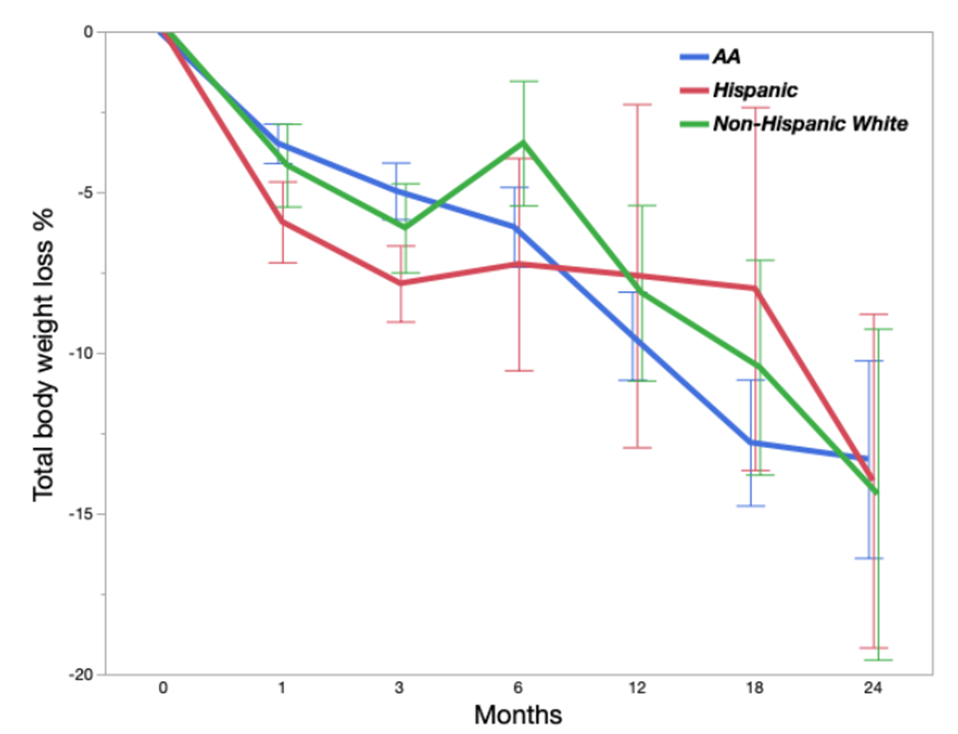Sunday Poster Session
Category: Interventional Endoscopy
P1370 - Sociodemographic Determinants of Weight Loss Outcomes Following Transoral Outlet Reduction
Sunday, October 26, 2025
3:30 PM - 7:00 PM PDT
Location: Exhibit Hall
- JD
John Deng, MD
UTSW
Dallas, TX
Presenting Author(s)
John Deng, MD, Diego Anazco, MD, Julia Wool, BS, Ronald Blanco Montecino, MD, Alvaro Cadillo Arbaiza, MD, M. Sunil Matthew, MS, Shannon Shiffer, MSc, Jaime Almandoz, MD, Anna Tavakkoli, MD
UTSW, Dallas, TX
Introduction: Transoral outlet reduction (TORe) is an endoscopic procedure for weight recurrence after Roux-en-Y gastric bypass (RYGB). While studies have evaluated its long-term efficacy and safety, many have lacked racially and socioeconomically diverse populations. In this study, we assess factors associated with outcomes following TORe in a racially and socioeconomically diverse cohort.
Methods: We conducted a retrospective cohort study to include patients who underwent TORe due to insufficient weight loss or weight recurrence after RYGB from 2019 to 2025. Patients were identified from a prospectively managed registry of patients who underwent TORe. TORe were all performed under general anesthesia by a single endoscopist at an academic medical center. Clinical and anthropometric data was collected retrospectively up to 24 months after TORe from the electronic medical record. The primary outcome was the total body weight loss percentage (TBWL%) at 12-months by race/ethnicity
Results: A total of 72 patients (95.8% female, 58.3% African American (AA), 29.2% Non-Hispanic Whites (NHW), 12.5% Hispanic, mean age 53 ± 10.2 years, mean BMI 40.8 ± 9.5) completed TORe. The mean time from primary bariatric procedure to TORe was 169.7 ± 93.4 months and patients experienced mean weight recurrence of 40.7% ± 37.5. Hispanic patients had a trend towards higher weight recurrence percentage from nadir post-RYGB to pre-TORE weight (59.3% ± 66.3) than AA (43.6% ± 35.6) and NHW (27.7% ± 21.8; p=0.13). Hispanic patients also had a higher BMI at time of TORe (47.8 ± 3.1) than AA (42.1 ± 8.6) and NHW (35.3 ± 7.8; p=0.002). At 12-months after TORe (n=52), TBWL for AA was -9.4% ± 7.9, followed by NHW at -8.1% ± 10.2 and Hispanic patients at -7.5 % ± 11.9; (p=0.84).
Discussion: Hispanic patients had higher weight recurrence and BMI at time of TORe, suggesting delayed access to revisional procedures. Further research is needed to identify potential disparities in timely access to revisional bariatric endoscopic procedures and weight-loss outcomes.

Figure: Figure 1: Weight loss outcomes after TORe across race/ethnicity groups

Figure: Table 1: Baseline characteristics across race/ethnicity groups
Disclosures:
John Deng indicated no relevant financial relationships.
Diego Anazco indicated no relevant financial relationships.
Julia Wool indicated no relevant financial relationships.
Ronald Blanco Montecino indicated no relevant financial relationships.
Alvaro Cadillo Arbaiza indicated no relevant financial relationships.
M. Sunil Matthew indicated no relevant financial relationships.
Shannon Shiffer indicated no relevant financial relationships.
Jaime Almandoz: Boehringer Ingelheim – Consultant. Eli Lilly and Company – Consultant. Nestlé – Consultant. Novo Nordisk A/S – Consultant. Wave Life Sciences – Consultant.
Anna Tavakkoli indicated no relevant financial relationships.
John Deng, MD, Diego Anazco, MD, Julia Wool, BS, Ronald Blanco Montecino, MD, Alvaro Cadillo Arbaiza, MD, M. Sunil Matthew, MS, Shannon Shiffer, MSc, Jaime Almandoz, MD, Anna Tavakkoli, MD. P1370 - Sociodemographic Determinants of Weight Loss Outcomes Following Transoral Outlet Reduction, ACG 2025 Annual Scientific Meeting Abstracts. Phoenix, AZ: American College of Gastroenterology.
UTSW, Dallas, TX
Introduction: Transoral outlet reduction (TORe) is an endoscopic procedure for weight recurrence after Roux-en-Y gastric bypass (RYGB). While studies have evaluated its long-term efficacy and safety, many have lacked racially and socioeconomically diverse populations. In this study, we assess factors associated with outcomes following TORe in a racially and socioeconomically diverse cohort.
Methods: We conducted a retrospective cohort study to include patients who underwent TORe due to insufficient weight loss or weight recurrence after RYGB from 2019 to 2025. Patients were identified from a prospectively managed registry of patients who underwent TORe. TORe were all performed under general anesthesia by a single endoscopist at an academic medical center. Clinical and anthropometric data was collected retrospectively up to 24 months after TORe from the electronic medical record. The primary outcome was the total body weight loss percentage (TBWL%) at 12-months by race/ethnicity
Results: A total of 72 patients (95.8% female, 58.3% African American (AA), 29.2% Non-Hispanic Whites (NHW), 12.5% Hispanic, mean age 53 ± 10.2 years, mean BMI 40.8 ± 9.5) completed TORe. The mean time from primary bariatric procedure to TORe was 169.7 ± 93.4 months and patients experienced mean weight recurrence of 40.7% ± 37.5. Hispanic patients had a trend towards higher weight recurrence percentage from nadir post-RYGB to pre-TORE weight (59.3% ± 66.3) than AA (43.6% ± 35.6) and NHW (27.7% ± 21.8; p=0.13). Hispanic patients also had a higher BMI at time of TORe (47.8 ± 3.1) than AA (42.1 ± 8.6) and NHW (35.3 ± 7.8; p=0.002). At 12-months after TORe (n=52), TBWL for AA was -9.4% ± 7.9, followed by NHW at -8.1% ± 10.2 and Hispanic patients at -7.5 % ± 11.9; (p=0.84).
Discussion: Hispanic patients had higher weight recurrence and BMI at time of TORe, suggesting delayed access to revisional procedures. Further research is needed to identify potential disparities in timely access to revisional bariatric endoscopic procedures and weight-loss outcomes.

Figure: Figure 1: Weight loss outcomes after TORe across race/ethnicity groups

Figure: Table 1: Baseline characteristics across race/ethnicity groups
Disclosures:
John Deng indicated no relevant financial relationships.
Diego Anazco indicated no relevant financial relationships.
Julia Wool indicated no relevant financial relationships.
Ronald Blanco Montecino indicated no relevant financial relationships.
Alvaro Cadillo Arbaiza indicated no relevant financial relationships.
M. Sunil Matthew indicated no relevant financial relationships.
Shannon Shiffer indicated no relevant financial relationships.
Jaime Almandoz: Boehringer Ingelheim – Consultant. Eli Lilly and Company – Consultant. Nestlé – Consultant. Novo Nordisk A/S – Consultant. Wave Life Sciences – Consultant.
Anna Tavakkoli indicated no relevant financial relationships.
John Deng, MD, Diego Anazco, MD, Julia Wool, BS, Ronald Blanco Montecino, MD, Alvaro Cadillo Arbaiza, MD, M. Sunil Matthew, MS, Shannon Shiffer, MSc, Jaime Almandoz, MD, Anna Tavakkoli, MD. P1370 - Sociodemographic Determinants of Weight Loss Outcomes Following Transoral Outlet Reduction, ACG 2025 Annual Scientific Meeting Abstracts. Phoenix, AZ: American College of Gastroenterology.

